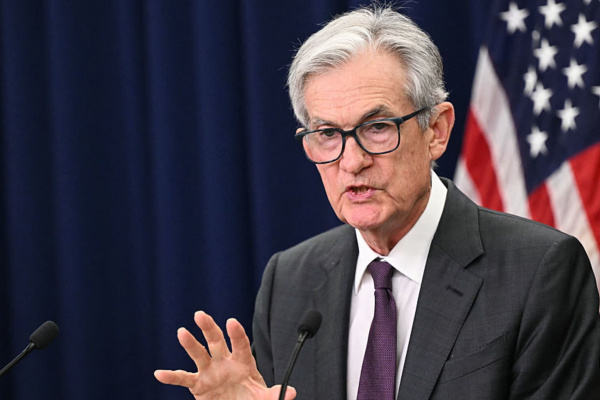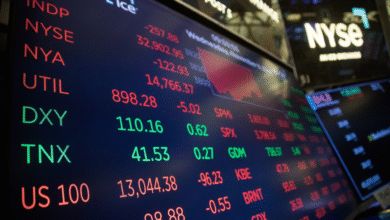Jerome Powell Interest Rate Cuts: Insights from Jackson Hole

Jerome Powell’s interest rate cuts are becoming a focal point in discussions surrounding Federal Reserve policy as markets anticipate shifts in monetary strategy. During his recent address at the Jackson Hole symposium, Powell hinted that upcoming conditions could merit reductions in interest rates, sparking excitement among investors and economists alike. The Fed’s cautious stance towards easing monetary policy reflects ongoing uncertainties, particularly concerning the impact of tariffs on inflation. As the September interest rate forecast takes center stage, many are looking to the Fed chair’s speeches for guidance. With other controversies swirling around the Federal Reserve, Powell’s comments hold immense significance in determining the future trajectory of interest rates.
The topic of interest rate adjustments led by Jerome Powell and the Federal Reserve involves critical discussions about the direction of the U.S. economy. Recently, the implications of potential monetary policy revisions have drawn significant attention, especially with Powell’s remarks at the annual gathering in Jackson Hole. Stakeholders are keenly assessing how these decisions will influence financial markets and consumer behavior. The forthcoming updates from the Fed are pivotal in shaping interest rate policy, particularly as various external factors complicate the economic landscape. As analysts scrutinize every detail from the Federal Reserve’s communications, the stakes remain high for future interest rate trajectories.
Jerome Powell’s Annual Address at Jackson Hole Symposium
On Friday morning, Federal Reserve Chair Jerome Powell addressed a gathering at the central bank’s annual symposium in Jackson Hole, Wyoming. This event traditionally serves as a platform for the Fed to outline its monetary policy trajectory and response to current economic conditions. In his speech, Powell discussed the intricate balance the Fed must maintain between fostering economic growth and managing inflationary pressures. His insights not only provide clues regarding immediate policy actions but also set the tone for future interest rate decisions.
Powell’s address comes at a pivotal moment, as market participants closely monitor the Federal Reserve’s interest rate strategy. With clear implications for the interest rate forecast, his comments on potential interest rate cuts reflect the Fed’s intention to navigate cautiously amid fluctuating economic indicators. The anticipation of these cuts has stirred discussions and analyses surrounding the possible impacts on markets and the broader economy.
Interest Rate Cuts and Federal Reserve Policy
The conversation around Jerome Powell interest rate cuts is gaining traction as economic indicators suggest a potential shift in the Federal Reserve’s monetary policy. The cautious approach highlighted in Powell’s Jackson Hole speech indicates a willingness to adapt in response to evolving economic conditions. However, the decision to lower rates hinges on a thorough assessment of various factors, including inflation trends and the labor market’s stability.
The implications of interest rate cuts extend beyond immediate market reactions; they are crucial for shaping the Federal Reserve’s long-term policy framework. Easing monetary policy could stimulate economic activity, but it also carries risks, particularly if inflation begins to rise unexpectedly. As Powell and his colleagues weigh these considerations, markets eagerly anticipate updates on the Fed’s stance during upcoming Federal Reserve speeches.
Federal Reserve officials are currently navigating challenging waters, balancing the need for economic support with the risks associated with monetary policy easing. Their deliberations are further complicated by external pressures, including political criticism over budgetary expenditures and project management. As the Fed prepares for critical discussions in September, the anticipation surrounding interest rate adjustments continues to build, reflecting broader concerns about the economy.
Market Reactions to Powell’s Speech
Market participants reacted strongly to Powell’s comments at the Jackson Hole symposium, reflecting the delicate state of the economy. Investors quickly absorbed hints about possible interest rate cuts, which could bolster equities but also create volatility in fixed income markets. The focus on Jerome Powell’s interest rate hints illustrates the pivotal role the Fed plays in shaping market perceptions and expectations.
Following his address, analysts began to adjust their interest rate forecasts, contemplating how upcoming data releases might influence the Fed’s decisions. The anticipation of an imminent interest rate cut raises questions about the effectiveness of monetary policy in a landscape marked by uncertainty and mixed economic signals. As speculations mount, all eyes will be on the Federal Reserve’s next steps and how they aim to communicate their strategies amidst criticism and external variables.
Impact of Political Pressures on Federal Reserve Decisions
The tensions between the Federal Reserve and political figures highlight the challenges that Jerome Powell faces in his role as Chair. Criticism from the White House regarding the Fed’s spending on renovations alongside calls for resignations draws attention to the intersection of monetary policy and political interests. These external pressures may complicate the Fed’s ability to implement the monetary policy updates it deems necessary.
Despite the swirling controversies, Powell’s focus remains on the broader economic picture, emphasizing the Fed’s commitment to making informed decisions based on data. As policymakers address complex issues related to inflation and employment, the potential for interest rate cuts remains on the table. Still, the interplay between political influence and economic indicators will significantly inform the Federal Reserve’s actions in the months to come.
Future Monetary Policy: Caution and Considerations
As Jerome Powell speaks cautiously about future monetary policy, the Federal Reserve grapples with persistent uncertainties. The effectiveness of any adjustments to interest rates will depend substantially on the evolving economic landscape, global trade conditions, and inflation dynamics. Policymakers are tasked with making decisions that not only stabilize the economy but also maintain public confidence in the Fed’s independence.
In this context, the forthcoming monetary policy updates will likely prioritize a careful assessment of the implications of interest rate cuts. Observers anticipate that Powell will emphasize the importance of data-driven decisions in subsequent Federal Reserve speeches, particularly as economic indicators continue to fluctuate. The balance between growth-supportive measures and inflation control will play a critical role in shaping the Fed’s efforts moving forward.
Jackson Hole Symposium: A Platform for Central Bank Updates
The annual Jackson Hole symposium has long been an important event on the central banking calendar, serving as an opportunity for leaders within the Federal Reserve to communicate their views on economic policy and to signal future directions. This gathering presents an ideal platform for engaging with international economists and policy makers, fostering discussions that can influence global monetary policies.
This year, Jerome Powell’s address provided key insights into the Fed’s approach to current challenges, including inflation controls and employment figures. The symposium not only highlights the complexities of Federal Reserve policy but also underscores the significance of effective communication in shaping market expectations and responses to potential interest rate changes.
The Role of Inflation in Monetary Policy Decisions
Inflation remains a focal point in the discussions surrounding Federal Reserve monetary policy, particularly as policymakers contemplate interest rate cuts. Powell’s speech at Jackson Hole reiterated the uncertainty surrounding inflation’s trajectory, particularly in light of external factors such as tariffs. The Fed’s approach to inflation is crucial, as it influences public perception and investor confidence.
An increase in inflation could complicate the Federal Reserve’s decision-making process regarding interest rates. Therefore, the careful analysis of inflation trends will continue to inform the Fed’s strategy as it considers potential adjustments to its monetary policy during its upcoming meetings. The balance between stimulating growth and ensuring price stability will remain a key theme in future Federal Reserve updates.
Interest Rate Forecasts: Market Implications and Strategies
Following Powell’s address, market analysts are re-evaluating their interest rate forecasts, which can have significant implications for various sectors of the economy. The anticipation of interest rate cuts has the potential to influence borrowing costs, consumer spending, and overall economic growth. Investors are particularly attentive to the Fed’s approach in light of changing economic conditions and the global landscape.
Effective interest rate forecasting requires a nuanced understanding of the interplay between domestic factors and international economic developments. As markets adapt to Powell’s insights and projections, the emphasis will shift to how the Federal Reserve’s strategy will evolve to address both current challenges and future uncertainties. Regular updates from the Fed will be vital in maintaining clarity and managing market expectations.
The Federal Reserve’s Balancing Act: Growth vs. Control
The Federal Reserve finds itself continually balancing the need to promote economic growth against the imperatives of controlling inflation. As highlighted in Powell’s recent address, this balancing act is complex, especially amidst external pressures and political scrutiny. The potential for interest rate cuts emerges as a tool for the Fed to navigate these competing goals responsibly.
The effectiveness of the Fed’s approach will depend on its ability to communicate its rationale for monetary policy decisions to both markets and the public. This transparency is essential in maintaining credibility and ensuring that stakeholders understand the underlying factors influencing interest rate cuts. As the Fed continues to evaluate its policy trajectory, maintaining this balance will be integral to its long-term economic strategy.
Frequently Asked Questions
What did Jerome Powell say about interest rate cuts at the Jackson Hole symposium?
During his speech at the Jackson Hole symposium, Federal Reserve Chair Jerome Powell indicated that the economic conditions may warrant interest rate cuts in the near future, but stressed that any changes to monetary policy would be approached with caution.
How might Jerome Powell’s interest rate cuts affect the economy?
Jerome Powell’s interest rate cuts could stimulate economic growth by lowering borrowing costs for consumers and businesses, which would encourage spending and investment. However, the decision remains complex due to ongoing uncertainties like tariffs and inflation.
What is the market’s reaction to Jerome Powell’s interest rate forecast?
Markets have been closely monitoring Jerome Powell’s interest rate forecast, particularly for indications regarding a potential interest rate cut in September, as traders seek clues on how the Federal Reserve will manage monetary policy amid evolving economic conditions.
What controversies has the Federal Reserve faced amid discussions of interest rate cuts?
Amid discussions of potential interest rate cuts, the Federal Reserve has faced criticism regarding non-policy issues, including a costly renovation of its Washington D.C. headquarters and calls for resignation of certain officials, which has diverted attention from monetary policy updates.
When can we expect an update on Federal Reserve policy regarding interest rate cuts?
Updates on Federal Reserve policy, particularly related to interest rate cuts, typically follow key meetings and speeches by Jerome Powell, with significant updates often expected after the FOMC (Federal Open Market Committee) meetings or major economic events.
| Key Point | Details |
|---|---|
| Jerome Powell’s Address | Delivered at the annual symposium in Jackson Hole, Wyoming. |
| Interest Rate Cuts Indication | Powell stated that conditions may warrant interest rate cuts as the Fed proceeds carefully. |
| Market Expectations | Markets are looking for hints about a potential September interest rate cut. |
| Cautious Approach | Fed officials are cautious about easing monetary policy due to unclear inflation effects from tariffs. |
| Controversies | The Fed is facing non-policy controversies, including criticism from White House officials. |
| Governor Lisa Cook | Cook faced calls to resign over mortgage fraud allegations but refuses to step down. |
Summary
Jerome Powell interest rate cuts have become a focal point in recent discussions surrounding the Federal Reserve’s monetary policy. As the chair indicated the possibility for reducing rates amid careful considerations, this has led to increased speculation and anticipation within financial markets. While the Fed remains vigilant about the unknown impacts of tariffs on inflation, it also navigates through significant external pressures and controversies. Overall, Powell’s comments reflect a delicate balancing act as the central bank approaches future interest rate decisions.




